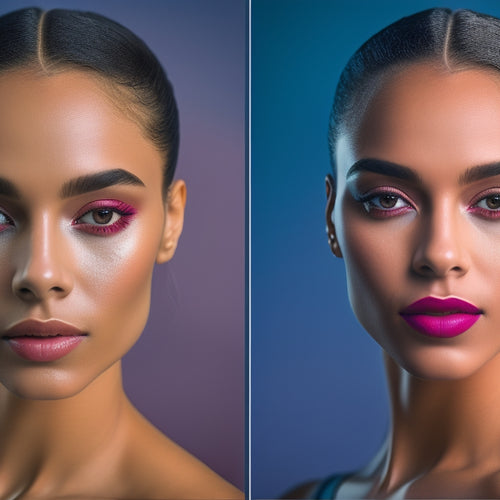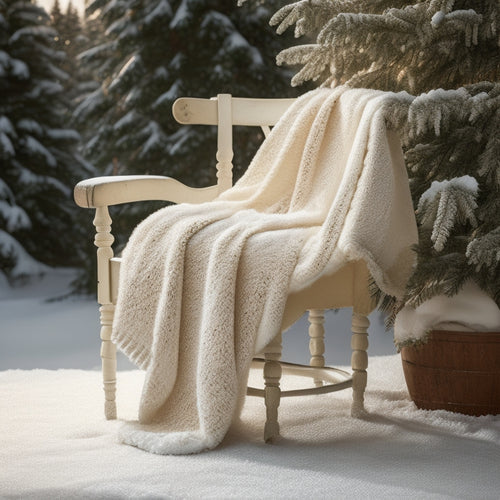
How Do You Keep a Dance Costume in Place?
Share
You guarantee your dance costume stays secure and in place by combining the right fabric, a perfect fit, and strategic use of adhesives, tapes, and clips. A well-fitting costume allows for a full range of motion, while carefully placed adhesives and tapes hold decorations in place. Pins and needles secure the costume, and the right clips anchor fabric securely. Finally, final checks before performance guarantee a confident, unrestricted show. Want to master the details that make a difference?
Key Takeaways
• Use adhesives and tapes strategically to secure decorations and hold fabric in place, ensuring a comfortable fit and full range of motion.
• Position costume clips along seams to anchor fabric securely, choosing clips suitable for fabric weight and stretch limits.
• Opt for stretchy fabrics like spandex, lycra, or nylon that move with you, enhancing confidence and freedom while dancing.
• Conduct quick rehearsals to ensure familiarity with choreography and make last-minute adjustments to costume for secure straps, zippers, and ties.
• Use pins and needles carefully to hold the costume securely in place, maintaining proper thread tension to avoid fabric damage.
Choosing the Right Fabric Matters
When selecting fabric for your dance costume, opt for materials that not only complement your dance style but also provide the necessary comfort, flexibility, and durability to keep you moving freely.
Fabric durability is essential, as it guarantees your costume can withstand the demands of your performance. Look for stretchy options like spandex, lycra, or nylon that provide a full range of motion. These fabrics will move with you, allowing you to focus on your dance rather than worrying about your costume.
Additionally, consider moisture-wicking fabrics to keep you dry and cool during intense performances. By choosing the right fabric, you'll be able to dance with confidence and freedom, knowing your costume can keep up with your every move.
Selecting a Well-Fitting Costume
When selecting a well-fitting costume, you'll want to make sure of a snug yet comfortable fit that allows for a full range of motion, taking into account your body shape, the style of dance, and the specific demands of your performance.
To achieve this, take your body measurements carefully, considering factors like bust, waist, and inseam. Compare these measurements to the costume's size chart to guarantee a good fit.
If needed, plan for costume alterations to make adjustments for a perfect fit. A well-fitting costume will give you the freedom to move confidently and focus on your performance, rather than worrying about wardrobe malfunctions.
Using Adhesives and Tapes
When you're using adhesives and tapes to keep your dance costume in place, you'll need to focus on securing decorations and holding fabric in position.
You'll want to choose the right adhesive or tape for the specific materials you're working with, whether it's fabric, sequins, or beads. By doing so, you'll guarantee a secure and long-lasting hold that will withstand the demands of your performance.
Securely Attaching Decorations
Attaching decorations securely to your dance costume necessitates careful selection and application of adhesives and tapes to guarantee they stay in place throughout your performance. You'll want to choose adhesives that won't damage your costume's fabric or compromise its integrity.
Conduct adhesive tests on an inconspicuous area to verify the adhesive you've selected won't cause discoloration or damage. When applying decorations, use a combination of adhesives and tapes to secure them firmly. Consider adding decorative weights to prevent decorations from shifting during movement.
Holding Fabric in Place
You can use a combination of adhesives and tapes to secure fabric in place, guaranteeing a secure and comfortable fit that allows for a full range of motion during your performance.
When choosing an adhesive or tape, consider the fabric weight and type. For lighter fabrics, a gentle adhesive or tape is suitable, while heavier fabrics may require a stronger hold.
Steaming techniques can also help relax the fabric, making it easier to work with.
Apply the adhesive or tape strategically, focusing on areas prone to shifting or bunching. Ensure a strong bond by following the manufacturer's instructions and allowing adequate drying time.
With the right combination of adhesives and tapes, you can enjoy a worry-free performance, free to focus on your art.
Securing With Pins and Needles
To guarantee your dance costume from shifting during performance, strategically place pins and needles to hold it securely in place. When using needles, prioritize safety by handling them carefully and storing them in a secure container when not in use.
Maintain proper thread tension by gently tugging on the thread to avoid over-tightening, which can cause fabric damage. As you pin your costume, start with the most critical areas, such as the bodice or sleeves, and work your way outward.
Use a thimble to protect your fingers from the needle and maintain control. By following these guidelines, you'll be able to confidently take the stage, knowing your costume is securely in place.
The Power of Costume Clips
When you're working with delicate fabrics, you'll want to choose clips specifically designed for your material, whether it's lace, satin, or tulle. By selecting the right clip, you'll guarantee a secure hold without damaging your costume.
With the right clips in place, you can confidently focus on perfecting your routine, knowing your costume will stay put.
Secure the Fabric
Costume clips, strategically positioned along the seams, can discreetly anchor the fabric of your dance costume, preventing embarrassing slippages during performances.
When securing the fabric, consider the weight of the fabric and its stretch limits. Heavier fabrics, like velvet or satin, require stronger clips to prevent drooping, while lighter fabrics, like chiffon or tulle, need gentler clips to avoid damage.
You'll want to position clips at stress points, such as the shoulders, waist, or hips, where the fabric is most prone to shifting.
Clips for Different Fabrics
Your choice of clip type hinges on the specific fabric you're working with, as different materials respond uniquely to various clip designs and strengths.
For lightweight fabrics like chiffon or organza, you'll want clips with a gentle grip to guarantee protection.
Heavier fabrics like velvet or satin require stronger clips with a firmer hold.
Delicate fabrics like silk or lace demand clips with a soft, padded surface to avoid scratching.
Consider the fabric weights and choose clips made from materials that complement them. For instance, metal clips are suitable for heavier fabrics, while plastic or nylon clips work better for lighter materials.
Strategically Placing Safety Pins
To ensure a secure fit, you'll want to strategically place safety pins at stress points, like the seams and joints, where the fabric is most likely to come undone. This will prevent wardrobe malfunctions and give you the freedom to focus on your performance.
When using safety pins, it's crucial to use the right pinning techniques and tools. Here are some tips to keep in mind:
- Use high-quality safety pins designed specifically for dance costumes, as they're typically stronger and more durable.
- Choose the correct pin size for the fabric thickness to avoid visible bulges or puckering.
- Experiment with different pinning techniques, such as vertical or horizontal pinning, to find what works best for your costume design.
Adding a Lining for Security
By incorporating a lining into your dance costume, you establish an additional layer of security that prevents revealing mishaps and enhances overall performance confidence. This inner layer provides a smooth, comfortable fit and prevents the outer fabric from clinging to your skin.
When choosing lining options, consider factors like breathability, moisture-wicking properties, and anti-chafing features. You can opt for a built-in lining or attach a separate inner layer. Some popular lining options include mesh, silk, or cotton blends.
Guarantee a snug fit by taking your measurements and adjusting the lining accordingly. A well-designed lining provides the freedom to focus on your performance, rather than worrying about wardrobe malfunctions.
With a secure and comfortable lining, you'll be able to dance with confidence and poise.
Dancing in Comfortable Shoes
Proper footwear selection can greatly impact your overall dance performance. Shoes that fit comfortably and provide adequate support enable you to focus on technique and artistry rather than discomfort or pain.
When choosing dance shoes, consider the following key factors:
-
Sole Support: Look for shoes with a sturdy sole that provides arch support and cushioning to absorb shock and reduce fatigue.
-
Heel Height: Select shoes with a heel height that allows for proper alignment and balance, ensuring you can move freely and comfortably.
-
Breathability: Opt for shoes with breathable materials to keep your feet cool and dry during performance.
Final Checks Before Performance
You've selected your comfortable shoes, now it's time to focus on the final preparations that guarantee your dance costume stays in place throughout the performance.
Conduct quick rehearsals to make sure you're comfortable with the choreography and can move freely without any restrictions. Make any last adjustments to your costume, double-checking that all straps, zippers, and ties are secure.
Take a few moments to visualize yourself performing confidently and freely, with your costume staying in place. With these final checks complete, you'll feel empowered to take the stage, knowing your costume won't hold you back.
You're ready to shine!
Frequently Asked Questions
How Do You Prevent Sequins From Falling off During a Performance?
To prevent sequins from falling off during a performance, you apply fabric adhesive to secure them, and reinforce with thread for added hold, ensuring a dazzling, worry-free show.
Can You Use Hot Glue to Attach Decorations to a Dance Costume?
You can use hot glue to attach decorations, but consider the adhesive strength and fabric type; opt for a flexible adhesive like E6000 or Gem-Tac for a strong, durable bond that won't restrict movement.
How Do You Keep a Tutu From Slipping Down During a Ballet?
You've likely experienced the frustrating sensation of a slipping tutu during a ballet performance. To combat this, you can rely on Tutu Tapes or Waist Wraps, securing your tutu in place, allowing you to dance freely.
Are There Special Tapes for Sensitive Skin in Dance Costumes?
When choosing adhesives for sensitive skin, you'll find hypoallergenic options specifically designed for dance costumes. Always perform skin testing before applying, and look for certifications like dermatologist-approved or fragrance-free to guarantee a comfortable, irritation-free performance.
Can You Use Magnets to Hold a Costume Piece in Place?
As you step into the spotlight, imagine a magnetic force holding your costume together. Yes, you can use magnets to secure a costume piece in place, leveraging the Magnetic Grip of a specialized Costume Clasp for a worry-free performance.
Related Posts
-

Why Lyrical Dancers Need Pro Makeup Guidance Online
As a lyrical dancer, you know that a polished, performance-ready look is essential to showcasing your skills and conv...
-

Winter Dance Blanket: Perfect Super Bulky Knit
The Winter Dance Blanket is a delightful super bulky knit pattern designed for effortless creation, featuring a simpl...
-

Unleashing Business Success Through Dance E-Learning
Dance e-learning is revolutionizing business success by making high-quality training accessible to aspiring dancers w...


